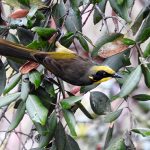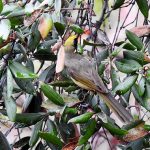YELLOW-TUFTED HONEYEATER
The Yellow-tufted Honeyeater is a striking bird, easily recognisable by its vivid yellow plumage and distinctive black facial mask. The most eye-catching feature is the bright yellow tuft behind each eye, which gives the species its name. The rest of its body is primarily olive-brown, with a brighter yellow on the underparts and wings, adding to its colourful and lively look.
This honeyeater is predominantly found in south-eastern Australia, favouring open forests and woodlands dominated by eucalyptus trees. It thrives in areas with dense undergrowth, often near water sources. The bird is particularly common in the coastal and sub-coastal regions of Victoria, New South Wales, and southern Queensland.
The Yellow-tufted Honeyeater is known for its varied and melodious calls. Its vocalisations include a series of clear, ringing notes that can carry through the forest. These calls are often used to communicate with other honeyeaters and to establish territory.
As its name suggests, the Yellow-tufted Honeyeater is primarily a nectar feeder. It has a preference for the nectar of eucalyptus flowers, but it also supplements its diet with insects, spiders, and occasionally fruits. This varied diet helps it to thrive in its natural habitat, especially when nectar is scarce. They are quite social and are often seen in small groups, especially during feeding.
By feeding on nectar, they play a crucial role in pollinating native plants, contributing to the health of their ecosystem. They have adapted well to various habitats, including gardens and urban areas, where native plants are present.
Breeding season for the Yellow-tufted Honeyeater typically occurs from July to January. During this time, they build cup-shaped nests made from bark strips, grass, and spider webs, usually positioned in dense shrubbery or low trees. The female lays two to three eggs, which she incubates for about two weeks. Both parents share the responsibility of feeding the chicks once they hatch.
The nests of Yellow-tufted Honeyeaters are intricately woven structures, often well-hidden in the foliage to protect against predators. They are small and compact, providing a snug environment for the eggs and chicks.
Yellow-tufted Honeyeaters can live for several years, although specific data on their lifespan is limited. Their survival largely depends on habitat conditions and availability of food resources.
Currently, the Yellow-tufted Honeyeater is not considered to be at risk, and its conservation status is listed as “Least Concern.” However, habitat destruction and changes in land use could pose future threats, making habitat preservation important for their continued well-being.
The Yellow-tufted Honeyeater is a delightful bird that adds a splash of colour and a touch of music to the Australian landscape. Its presence in various habitats underscores the importance of preserving natural environments to maintain the rich biodiversity of the region.


